Pagos digitales
La tecnología digital está transformando la manera en que respondemos a las emergencias. Las innovaciones abarcan desde cómo identificar a las personas elegibles para recibir asistencia, hasta la recopilación de datos para evaluaciones y monitoreo, así como la comunicación con las comunidades afectadas por situaciones de crisis. Los sistemas de pago digital, incluidos los dispositivos móviles, cupones electrónicos y tarjetas (cuando se utilizan apropiadamente) pueden proporcionar asistencia más oportuna, más segura, más eficaz en relación al costo, y más inclusiva. Sin embargo, a medida que el volumen de los datos personales que recogemos, almacenamos y compartimos sobre la gente crece, debemos garantizar que nuestros sistemas de protección de datos se mantienen al día, y que comprendemos y mitigamos los riesgos inherentes a las nuevas tecnologías.
Últimos recursos
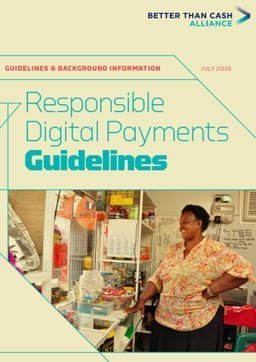
Responsible Digital Payments Guidelines
Guidelines and Tools
The focus of the Guidelines is on the common types of digital payments services provided to the financially underserved such as electronic money transaction accounts. For clients to adopt and use digital payments, they need to feel protected from risks such as loss of privacy, exposure to fraud, and...

Introducing the ELAN Data Starter Kit
Blog Post
Electronic cash transfers (e-transfers) often necessitate the transfer of personal data, some of which is sensitive, between humanitarian and private sector actors, such as financial service providers (FSPs). As use of e-transfers increases, having strong data management and protection practices in place...

Cash Transfers in Humanitarian Contexts
Report
Upon request of the Inter-Agency Standing Committee (IASC) Principals at their meeting on December 11, 2015, the World Bank agreed to coordinate a process of reviewing key issues and options for significantly scaling up the use of multipurpose cash transfers (MPCTs; including digital cash and vouchers) in...

Data management and protection starter kit: Tip sheet 1: Privacy Impact Assessment (PIA)
Guidelines and Tools
A Privacy Impact Assessment (PIA) is a systematic analysis of the potential privacy risks related to data collected during program implementation. A PIA analyzes threats and risks to program data, including any legal and environmental factors, and develops mitigation strategies. PIAs help humanitarians...
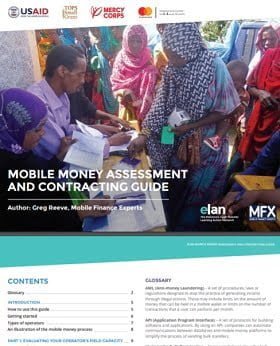
Mobile money assessment and contracting guide
Guidelines and Tools
Mobile money offers tremendous potential to enable cash transfers at scale and connect program participants to financial services. Oftentimes, however, humanitarian practitioners struggle to understand mobile money terminology to confidently evaluate different mobile money operators and to design...

UNHCR Cash Assistance: Improving refugees lives and supporting local economies
Report
UNHCR’s Cash-Based Interventions (CBI) support the most vulnerable Syrian refugees living within the host community in Jordan. Thanks to generous donor support last year, over 30,000 households received monthly cash assistance, winterisation cash, and cash for health, totalling nearly US $ 85 million....

DFID Shock-Responsive Social Protection Systems research: Literature review
Report
DFID has commissioned research into Shock-Responsive Social Protection systems, to further understand the nature of the interaction between social protection, humanitarian and disaster risk management systems and ways in which long-term social protection systems can be scaled up to
provide support in...
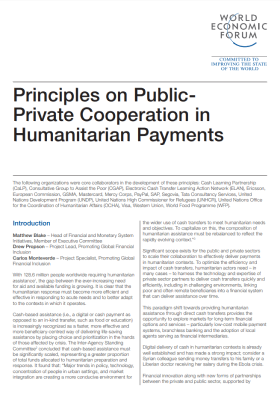
Principles on Public-Private Cooperation in Humanitarian Payments
Guidelines and Tools
E-payments can make the delivery of cash disbursements more secure, cost- effective, faster and more convenient. In the context of humanitarian crises, digital payments offer recipients choice and can help stimulate the local economy. To fully realize the benefits of new technologies and achieve scale,...

Can E-transfers Promote Financial Inclusion in Emergencies: A Case Study from Bangladesh
Report
The Electronic Cash Transfer Learning Action Network (ELAN) launched research to build an evidence base around connecting emergency electronic transfer (e-transfer) recipients with additional financial services. They wanted to learn if, when, and how e-transfers can promote sustained uptake and use...

ELAN Workshop Report: E-Transfers in Iraq and Syria
Report
This report outlines the main conclusions and takeways of ELAN workshop held in Iraq. The event was organized to meet the following objectives: Introduce participants to the what, why, and when of e-transfers. Explore solutions to the particular challenges of using e-transfers in Iraq and Syria. Share...
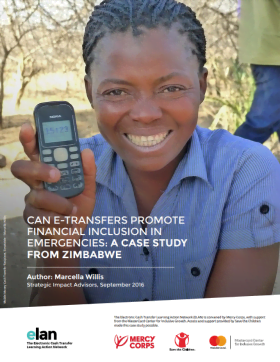
Can E-Transfers Promote Financial Inclusion in Emergencies: A Case Study from Zimbabwe
Case Study
The Electronic Cash Transfer Learning Action Network (ELAN) launched research to build an evidence base around connecting emergency electronic transfer (e-transfer) recipients with additional financial services. They wanted to learn if, when, and how e-transfers can promote sustained uptake and use...

ELAN Vocabulary and Usage
Guidelines and Tools
As e-transfer programs, technologies and products develop, key terms, phrases and working definitions are evolving alongside them. At the moment, these words and phrases are rarely standardized, and often hold unique meanings within different contexts and to different stakeholders. In order to facilitate...

Partnering with FSPs to Deliver Cash in Nepal: Top Considerations
Guidelines and Tools
Cash transfers are a proven way to help disaster-affected communities flexibly meet urgent basic needs. Several humanitarian agencies are planning cash transfers to support tens of thousands of Nepali earthquake survivors. While initial responses will likely rely on direct cash in envelopes, cash...
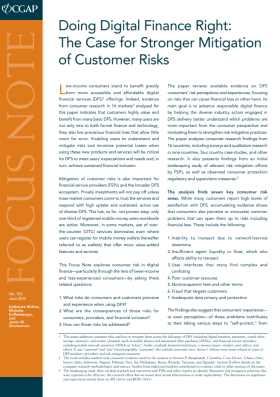
Doing Digital Finance Right: The case for stronger mitigation of customer risks
Policy paper
Low-income consumers stand to benefit greatly from more accessible and affordable digital financial services (DFS) offerings. Indeed, evidence from consumer research in 16 markets analyzed for this paper indicates that customers highly value and benefit from many basic DFS. However, many users are not...
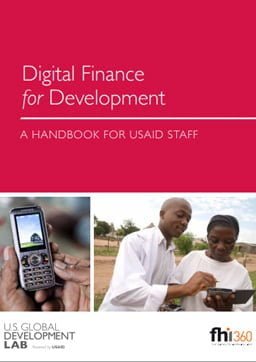
Digital Finance for Development: A Handbook for USAID Staff
Guidelines and Tools
This handbook is designed to enable USAID personnel to maximize the Agency’s use of and contribution to the growth of digital financial services in emerging markets around the world. As an Agency, USAID brings significant comparative advantages to the collective effort required to build out financial...

Seeking Solutions: New roles for technology in cash and voucher programs – An inspiration brief for technology and private sector partners
Policy paper
Today, more people have been forced to flee their homes than at the height of World War II. The scale of these humanitarian crises are challenging, and sometimes outpacing, the capacity of institutions created to respond to them. Yet, the approaches we have available to reach populations in need have also...
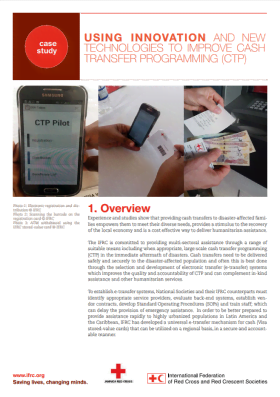
Using Innovation And New Technologies to Improve Cash Transfer Programming (CTP)
Report
Experience and studies show that providing cash transfers to disaster-affected families empowers them to meet their diverse needs, provides a stimulus to the recovery of the local economy and is a cost effective way to deliver humanitarian assistance. The IFRC is committed to providing multi-sectoral...

Financial Services Primer for Humanitarians
Guidelines and Tools
Financial services facilitate a wide range of economic and households activities in any society. They enable trade and business expansion and allow individuals to save, send and borrow money. Humanitarian cash transfers, particularly when delivered electronically,can expand access to financial services...
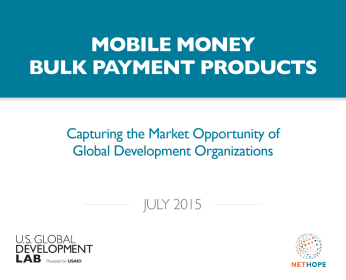
Mobile Money Bulk Payment Products: Capturing the market opportunity of global development organizations
Presentation
International relief and development organizations (DOs) receive significant aid funding from donors, which they regularly disburse in high volume, low value payments to millions of recipients for program and operational expenses. DOs and donors are increasingly using and promoting the use of new digital...
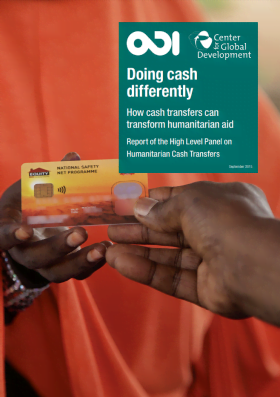
Doing Cash Differently: How cash transfers can transform humanitarian aid?
Policy paper
This report commissioned by the Overseas Development Institute highlights why giving aid directly in the form of cash is often a highly effective way to reduce suffering and to make limited humanitarian aid budgets go further. The publication, ,written by the High Level Panel on Humanitarian...


